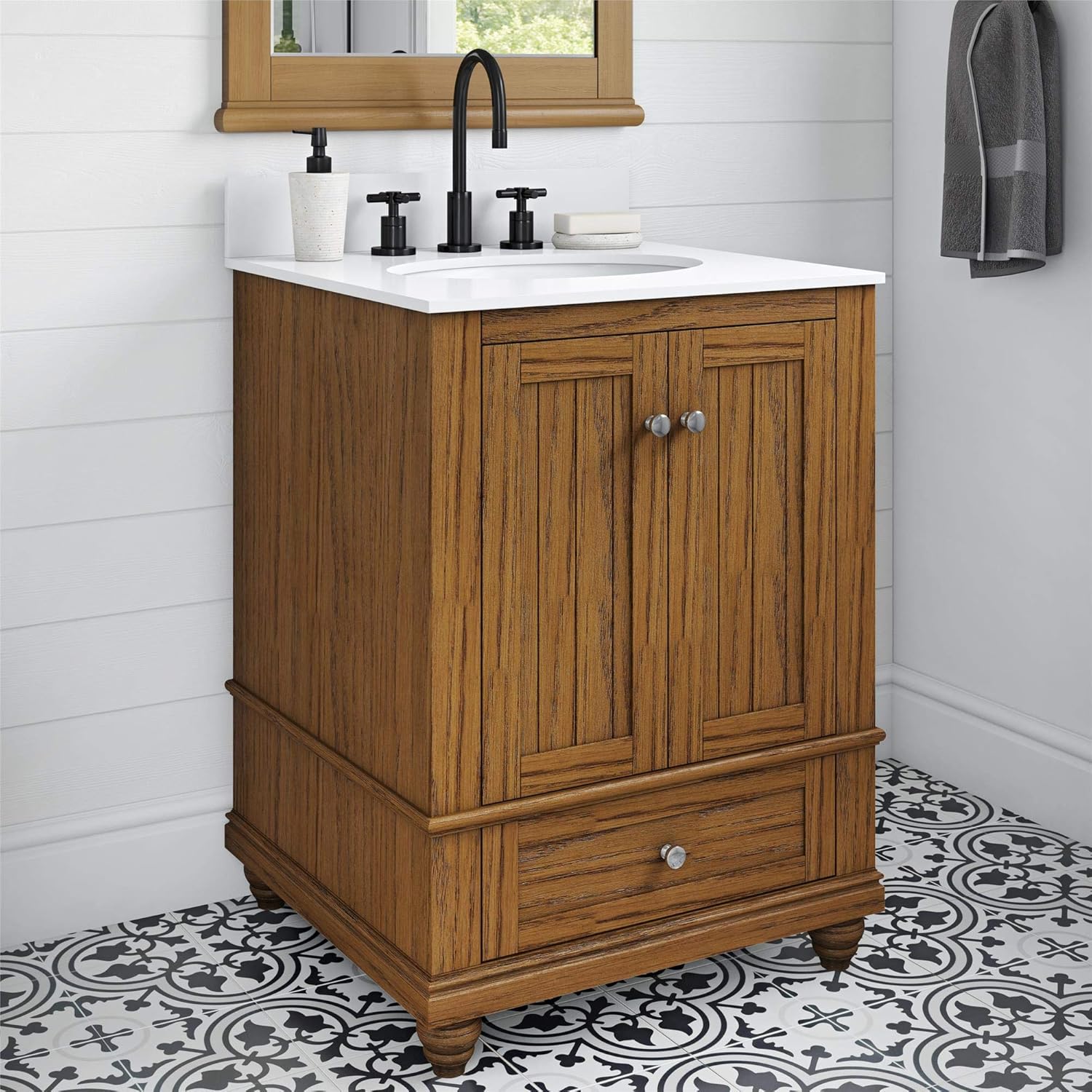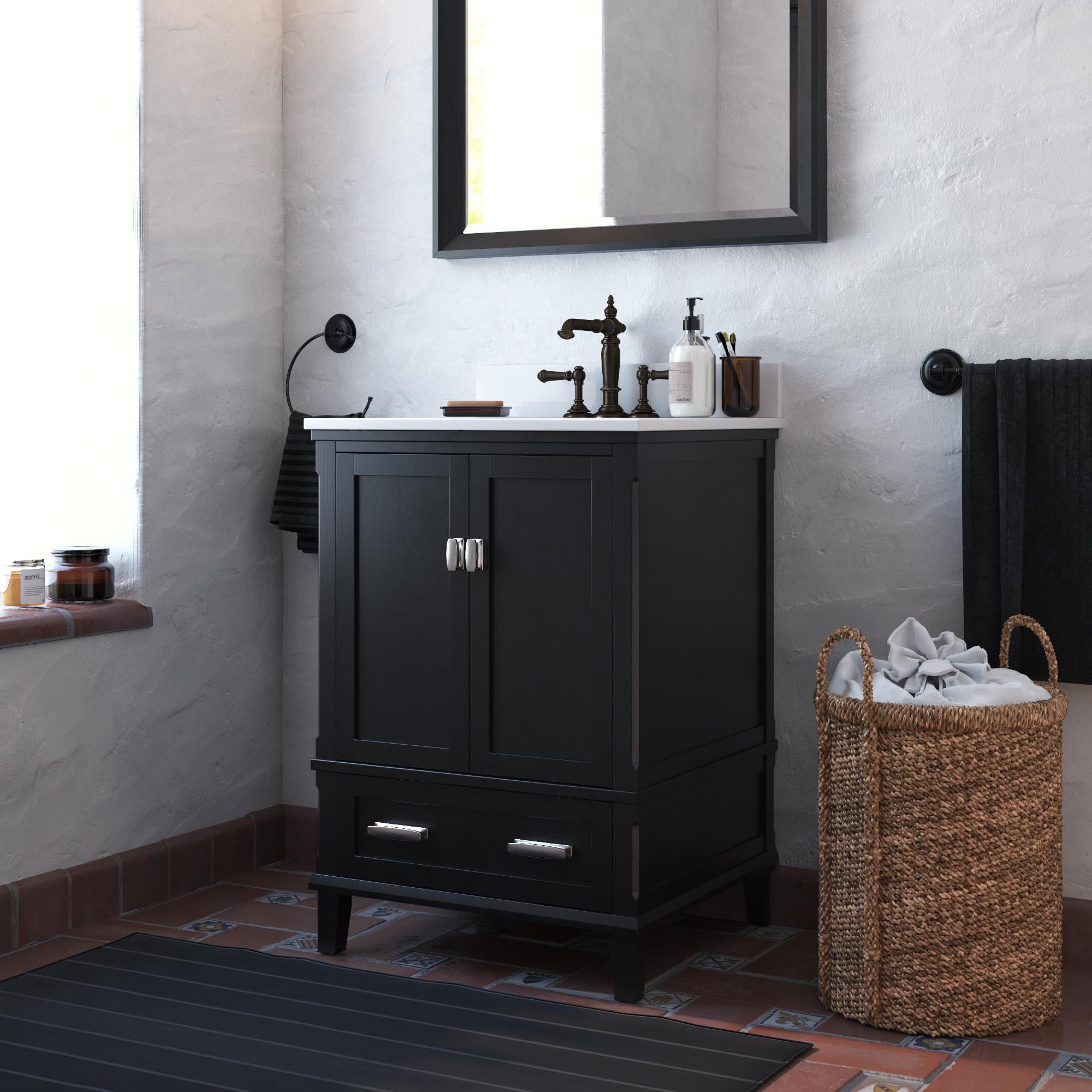Historical Context and Styles: 24 Inch Antique Bathroom Vanity

The evolution of bathroom vanities reflects a fascinating interplay of changing aesthetics, materials, and social values. From the simple washstands of the 19th century to the elaborate and functional designs of the early 20th century, bathroom vanities have evolved alongside the changing needs and aspirations of society.
Victorian Era Bathroom Vanities
The Victorian era (1837-1901) witnessed a surge in the popularity of elaborate and ornate furniture. This trend extended to bathroom vanities, which were often crafted from solid wood and adorned with intricate carvings, decorative hardware, and marble countertops. Victorian bathroom vanities typically featured a washstand with a built-in basin and a mirror. The era also saw the rise of the pedestal sink, a freestanding basin supported by a single column.
Edwardian Era Bathroom Vanities
The Edwardian era (1901-1910) saw a shift towards a more streamlined and simplified aesthetic. Edwardian bathroom vanities retained some of the Victorian era’s elegance but with a more refined and understated approach. They often featured simpler carvings and decorative elements, emphasizing functionality over ornamentation. The use of white enamel and porcelain became increasingly popular, reflecting a growing emphasis on hygiene and cleanliness.
Art Deco Bathroom Vanities
The Art Deco movement (1920s-1930s) brought a bold and geometric aesthetic to bathroom vanities. Art Deco designs often featured sleek lines, geometric patterns, and bold colors. Materials like chrome, nickel, and glass were frequently incorporated, adding a touch of glamour and modernity. Art Deco bathroom vanities often featured built-in mirrors and integrated lighting, reflecting the era’s fascination with technology and innovation.
Arts and Crafts Bathroom Vanities
The Arts and Crafts movement (1880s-1920s) emphasized craftsmanship and natural materials. Arts and Crafts bathroom vanities were typically made from solid wood, often with a rustic or handcrafted finish. The movement’s focus on simplicity and functionality was evident in the design of these vanities, which often featured open shelves and simple hardware. The Arts and Crafts movement also influenced the use of handcrafted tiles and ceramic sinks, reflecting a desire for natural beauty and authenticity.
Iconic 24-Inch Antique Bathroom Vanities
Several iconic designers and manufacturers left their mark on the history of 24-inch antique bathroom vanities. The work of Charles Rennie Mackintosh, a prominent figure in the Arts and Crafts movement, is renowned for its minimalist elegance and functional design. His bathroom vanities often featured simple, geometric forms and a focus on natural materials. Another notable designer, Frank Lloyd Wright, embraced a more organic and geometric aesthetic, creating bathroom vanities that seamlessly integrated with the surrounding architecture.
The Kohler Company, a prominent manufacturer of bathroom fixtures, has a long history of producing high-quality and stylish bathroom vanities. Their antique designs often incorporate classic elements like intricate carvings, decorative hardware, and elegant materials.
Materials and Construction

Antique 24-inch bathroom vanities are crafted from a variety of materials, each offering unique aesthetic and functional characteristics. The choice of materials often reflects the era and style of the vanity, as well as the preferences of the original owner. Understanding the materials and construction techniques employed in these vanities helps us appreciate their historical significance and understand their care requirements.
Common Materials Used in Antique Bathroom Vanities
The materials used in antique bathroom vanities vary widely, reflecting the changing trends and availability of resources over time. Here are some common materials used in the construction of these vanities:
- Wood: Wood is a popular material for antique vanities, providing both durability and aesthetic appeal. Common wood types include:
- Mahogany: Known for its rich reddish-brown color, mahogany is a strong and durable hardwood. It is often used in ornate vanities with intricate carvings and details.
- Oak: A sturdy and resilient hardwood, oak is available in various colors and grain patterns. It is often used in more rustic or traditional vanities.
- Cherry: Cherry wood is known for its warm reddish-brown tones and fine grain. It is often used in elegant and sophisticated vanities.
- Walnut: Walnut wood is prized for its rich brown color and distinctive grain pattern. It is often used in vanities with a more modern or contemporary feel.
- Pine: Pine is a softwood that is relatively inexpensive and easy to work with. It is often used in simpler, more utilitarian vanities.
- Marble: Marble is a natural stone that is often used for countertops and sinks in antique bathroom vanities. It is known for its elegant appearance and durability. Marble comes in a variety of colors and patterns, making it a versatile material for vanities.
- Porcelain: Porcelain is a ceramic material that is often used for sinks and basins in antique bathroom vanities. It is known for its durability, ease of cleaning, and resistance to stains.
- Metal: Metal is often used for hardware and fixtures in antique bathroom vanities. Common metals include brass, bronze, nickel, and chrome.
Durability and Maintenance of Antique Bathroom Vanities
The durability and maintenance requirements of antique bathroom vanities depend largely on the materials used in their construction.
- Wood: Wooden vanities are generally durable, but they require regular maintenance to prevent damage from moisture and wear. Wood can be finished with varnish, lacquer, or paint to protect it from water damage.
- Marble: Marble is a durable material, but it is porous and can be susceptible to staining. It should be sealed regularly to protect it from stains and scratches.
- Porcelain: Porcelain is a very durable material that is resistant to stains and scratches. It is also easy to clean.
- Metal: Metal hardware and fixtures can be durable, but they may require polishing or cleaning to maintain their appearance.
Material Characteristics and Benefits, 24 inch antique bathroom vanity
Here is a table outlining the characteristics and benefits of some common materials used in antique bathroom vanities:
| Material | Characteristics | Benefits |
|---|---|---|
| Mahogany | Rich reddish-brown color, strong and durable, often used in ornate vanities | Elegant appearance, durability, resistance to moisture |
| Oak | Sturdy and resilient, available in various colors and grain patterns, often used in rustic or traditional vanities | Durability, natural beauty, resistance to wear |
| Marble | Elegant appearance, durable, comes in a variety of colors and patterns | Versatility, natural beauty, durability |
| Porcelain | Durable, easy to clean, resistant to stains and scratches | Hygienic, low maintenance, long-lasting |
Restoring and Preserving Antique Vanities
Restoring an antique bathroom vanity is a labor of love that can breathe new life into a cherished piece of furniture. It’s a rewarding process that involves careful cleaning, refinishing, and repair techniques to bring back its original beauty and enhance its value. This guide provides a comprehensive approach to restoring a 24-inch antique bathroom vanity, focusing on preserving its unique character and historical significance.
Cleaning and Preparation
Before embarking on the restoration journey, it’s crucial to thoroughly clean the vanity to remove dirt, grime, and any coatings that may hinder the refinishing process. A gentle cleaning approach is essential to prevent damage to the antique finish.
- Dusting: Begin by dusting the vanity with a soft-bristled brush or a microfiber cloth to remove loose dust and debris.
- Mild Soap and Water: For a deeper clean, use a mild soap solution and a soft cloth to wipe down the surface. Avoid harsh chemicals or abrasive cleaners that can damage the antique finish.
- Specialized Cleaners: If the vanity has stubborn stains or residue, consider using a specialized cleaner designed for antique furniture. Follow the product instructions carefully.
Refinishing Techniques
Refinishing an antique bathroom vanity requires a delicate touch to preserve its original character while enhancing its appearance. Different refinishing techniques can be employed depending on the desired outcome and the condition of the vanity.
- Stripping: If the vanity has multiple layers of paint or varnish, stripping is necessary to remove the old finish and reveal the original wood. Chemical strippers are available, but they should be used with caution and proper ventilation.
- Sanding: After stripping, sanding the wood surface is essential to create a smooth finish. Start with coarse-grit sandpaper and gradually progress to finer grits for a polished look.
- Staining: Staining can enhance the natural beauty of the wood and create a desired color. Choose a stain that complements the vanity’s style and era.
- Sealing: After staining, sealing the wood protects it from moisture and wear. Apply a clear sealant that is compatible with the stain and the vanity’s environment.
Repairing Common Issues
Antique vanities often encounter common issues that require repair to restore their functionality and aesthetic appeal.
Water Damage
Water damage is a prevalent concern for antique bathroom vanities. If the vanity has sustained water damage, it’s crucial to address it promptly to prevent further deterioration.
- Drying: The first step is to thoroughly dry the vanity. Remove any wet materials and allow the wood to air dry completely.
- Mold Removal: If mold has grown, use a mold-killing solution to remove it. Follow the product instructions carefully.
- Wood Repair: Once the wood is dry, repair any damaged areas using wood filler or epoxy. Sand the repaired areas smooth.
Cracked Porcelain
Cracked porcelain is another common issue that can affect the vanity’s appearance and functionality.
- Cleaning: Clean the cracked area thoroughly to remove any debris or dirt.
- Epoxy Repair: Use a two-part epoxy to fill the crack. Apply the epoxy according to the manufacturer’s instructions.
- Sanding: Once the epoxy has cured, sand the repaired area smooth.
- Painting: If the repaired area is noticeable, paint it to match the surrounding porcelain.
Missing Hardware
Missing hardware can affect the vanity’s functionality and aesthetics.
- Identifying Hardware: Identify the missing hardware by researching similar antique vanities or consulting with a restoration expert.
- Finding Replacements: Seek out replacement hardware from antique stores, online retailers, or specialty hardware suppliers.
- Installation: Install the new hardware securely using appropriate screws or fasteners.
